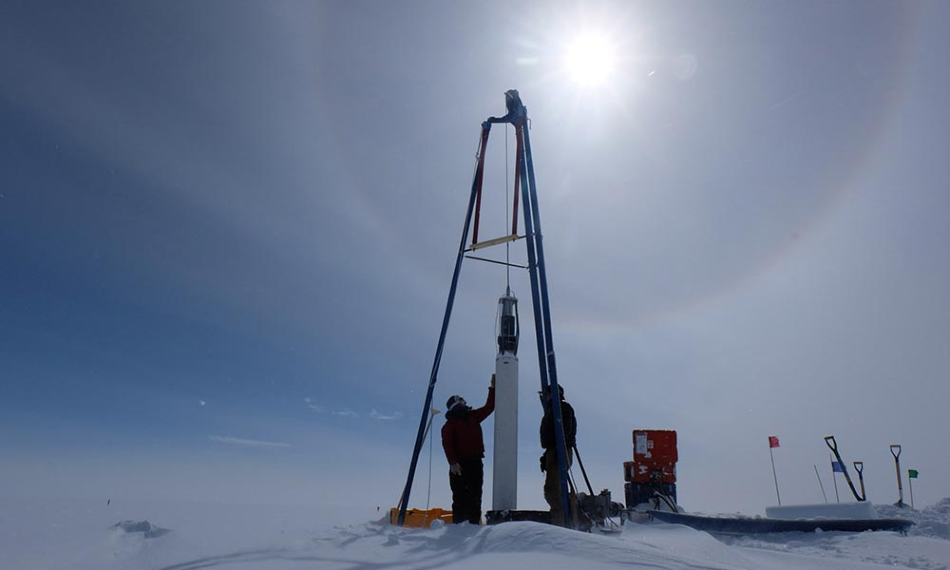 Rochester researchers in Greenland drill for ice cores, which contain air bubbles with small quantities of ancient air trapped inside. The researchers found that scientists have been vastly overestimating the amount of fossil methane emitted by natural sources, and have therefore been underestimating the amount of methane humans are emitting into the atmosphere via fossil fuels. Image Credit: Xavier Faïn / University of Grenoble Alpes
Rochester researchers in Greenland drill for ice cores, which contain air bubbles with small quantities of ancient air trapped inside. The researchers found that scientists have been vastly overestimating the amount of fossil methane emitted by natural sources, and have therefore been underestimating the amount of methane humans are emitting into the atmosphere via fossil fuels. Image Credit: Xavier Faïn / University of Grenoble Alpes
Researchers from the University of Rochester have determined that estimations regarding the amount of fossil methane that is emitted by natural sources have been vastly overestimated, and that calculations of methane emitted from human sources has been enormously underestimated. The latest data has uncovered that humans are adding even more methane into the atmosphere than was initially thought.
A Chance To Reduce Global Methane Emissions
Methane is one of the greatest contributors to global warming. It is estimated that emissions of the greenhouse gas have risen by 150% over the last 300 years, although concluding on the origins of these emissions has proven difficult.
There are two types of sources of methane gas, they can result from either natural or human activity. Monitoring how much is caused by humans is essential because we have control over human sources of emission, and can, therefore, establish plans to reduce these human-made emissions and reduce global warming.
A team of researchers at the University of Rochester recently conducted a study in which they measured the methane levels in samples of ancient air and concluded that natural emissions have been vastly overestimated over the years. In a paper published this month in the journal Nature, the Rochester scientists describe how these overestimations have led to human sources of methane emission being underestimated.
The team emphasizes that controlling human causes of methane emissions is vital to curbing climate change. We now have the opportunity to reduce emissions further than was previously assumed, because regulations can be put in place on the fossil fuel industry, whereas natural emissions are out of our hands.
The Difficulty Of Measuring Human-Attributed Methane Emissions
The two kinds of methane emitted into the atmosphere can be categorized on the basis of whether it includes a rare radioactive isotope known as carbon-14.
The fossil fuels of oil, gas, and coal used to power human activities do not contain this isotope because these fossil fuels are made over long periods of time, and as a result, the carbon-14 contained in these sources decays.
Biological methane, on the other hand, contains this isotope because it is released naturally into the atmosphere from natural sources before there is time for it to decay. This form of methane can come from natural sources, such as wetlands, but also from anthropogenic sources like livestock, rice fields, and landfills.
Therefore, it has been difficult for scientists to determine the full extent of methane emissions due to human activities as anthropogenic sources need to be taken into account alongside the isotope-free fossil fuel-related methane, but anthropogenic sources are hard to separate from naturally occurring methane as neither contain carbon-14.
The Rochester researchers set out to establish a method of accurately separating natural and anthropogenic components. To achieve this, the team looked to the past and collected ice cores from Greenland. These samples contain air bubbles from hundreds of years ago that contain small amounts of air. Researchers melted the samples, gaining access to the ancient air, and then studied it for its chemical composition.
The levels of carbon-14 isotopes were measured in the samples, which led the researchers to determine that up until around 1870, at the time of the industrial revolution, almost all the methane emitted into the atmosphere was from biological sources.
The team was able to determine that naturally released fossil methane accounts for around 10 times less of the methane in the atmosphere than was previously estimated. This led researchers to conclude that the manmade fossil component is 25-40% higher than previously estimated.
Reducing Methane Makes More Instantaneous Impact On Global Warming Than Reducing Carbon Does
While methane is the second-largest source of human activity-caused greenhouse gas emissions after carbon dioxide, reducing its emissions is more instantaneously impactful on global warming in comparison with reducing carbon emissions. While carbon dioxide persists in the atmosphere long after the source of emission is removed, methane has a relatively short shelf-life.
Carbon dioxide will linger in the atmosphere for up to a century even after the source of emission has been removed, whereas methane will only persist for around nine years. Therefore, methane is an attractive target for tackling emissions rapidly, as changes to global warming will be detected much more quickly. Initiating regulations to tackle methane could prove to be key in bringing down emissions to meet the tight targets that have been implemented by governments worldwide.
Disclaimer: The views expressed here are those of the author expressed in their private capacity and do not necessarily represent the views of AZoM.com Limited T/A AZoNetwork the owner and operator of this website. This disclaimer forms part of the Terms and conditions of use of this website.